Fire season may be over (for now) – but the monumental task of hardening the grid to protect against future fires is ongoing, particularly in the areas of California that are considered to be at the highest risk of fire.
With a town motto of “More Trees Than People,” the quaint Sierra Nevada community of Twain Harte is unquestionably one of those areas. Known for breathtaking vistas and idyllic, snowy winters, Twain Harte is a mountain lover’s paradise – but its proximity to the Stanislaus National Forest means that it’s surrounded by fire fuel, which is why IBEW 1245 members have been hard at work to harden the grid in order to mitigate the risk of fire in the area.
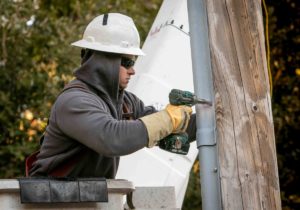 When the Utility Reporter took a trip up to Twain Harte this winter, temperatures were near freezing, and a big snowstorm was looming on the horizon – but despite the blustery weather, PG&E GC line crews were on the job, replacing poles and running new, more fire-resistant tree wire through Twain Harte’s neighborhoods.
When the Utility Reporter took a trip up to Twain Harte this winter, temperatures were near freezing, and a big snowstorm was looming on the horizon – but despite the blustery weather, PG&E GC line crews were on the job, replacing poles and running new, more fire-resistant tree wire through Twain Harte’s neighborhoods.
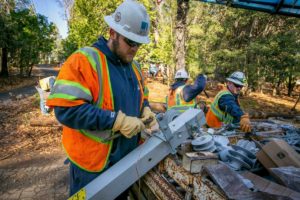 “The tree wire itself is not the easiest to deal with compared to what we’re used to,” said Hugo Madrigal, GC line foreman out of the Merced yard. “It’s more work to dead-end it, more rigging, different style grips. A different way of doing things.”
“The tree wire itself is not the easiest to deal with compared to what we’re used to,” said Hugo Madrigal, GC line foreman out of the Merced yard. “It’s more work to dead-end it, more rigging, different style grips. A different way of doing things.”
“It just takes a lot more time than working with regular wire, because of the way you got to strip it and prep it,” added Lineman Mark Vann. “It’s heavier, and there are a lot of different limitations, like on angles and stuff like that. Before [with the bare wire] we could just make it an angle. Now, we’ve got to make it a double arm angle or make it a double dead end. It’s more time consuming.”
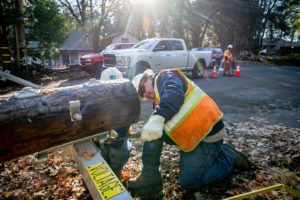 In order to sustain the heavier wire, the crews first needed to frame and set new heavy-duty poles. However, replacing these poles — amidst a plethora of trees, on narrow, winding mountain roads — was a far cry from what the Central Valley-based crews were accustomed to. But despite the challenging terrain and blustery weather conditions, they took the work in stride. They knew that once the snow set in, they would most likely have outages to attend to, so they wanted to get as much of the job done, safely and meticulously, before the storm arrived.
In order to sustain the heavier wire, the crews first needed to frame and set new heavy-duty poles. However, replacing these poles — amidst a plethora of trees, on narrow, winding mountain roads — was a far cry from what the Central Valley-based crews were accustomed to. But despite the challenging terrain and blustery weather conditions, they took the work in stride. They knew that once the snow set in, they would most likely have outages to attend to, so they wanted to get as much of the job done, safely and meticulously, before the storm arrived.
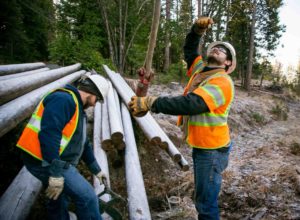 With so many challenges to work around, the members appreciated seeing representatives from their union out on the jobsite. For Madrigal, the foreman, there’s just no way to put a price on the job security that he and his crew are afforded through IBEW 1245.
With so many challenges to work around, the members appreciated seeing representatives from their union out on the jobsite. For Madrigal, the foreman, there’s just no way to put a price on the job security that he and his crew are afforded through IBEW 1245.
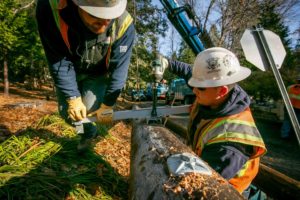 “[With IBEW representation] management can’t just fire somebody, and I can go to work knowing if something were to happen, I have some backing from the union, so I’m not alone against a billion-dollar company,” he said. “So I have that peace of mind — and that, to me, is worth more than a dollar amount.”
“[With IBEW representation] management can’t just fire somebody, and I can go to work knowing if something were to happen, I have some backing from the union, so I’m not alone against a billion-dollar company,” he said. “So I have that peace of mind — and that, to me, is worth more than a dollar amount.”
Photos by John Storey